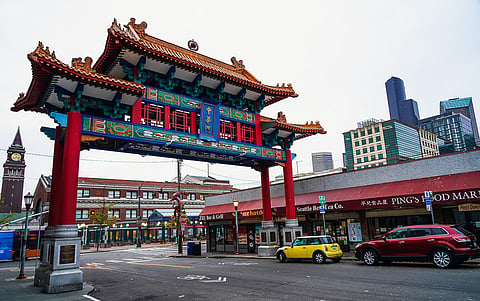OPINION | It's Time for a Hard Conversation: The CID Is Not Your Talking Point
by Asian Pacific Americans for Civic Engagement (APACE) PAC
The Chinatown-International District is hurting. The recent vandalism of the Wing Luke Museum showed that anti-Asian hate is alive and well. The cancellation of the CID Night Market was a blow to our small businesses, still hurting after the pandemic.
Yet many in the media and positions of power — or seeking power — have been using the CID, which spans Chinatown, Filipino Town, Japantown, and Little Saigon, to advance their personal agendas and platforms while conveniently forgetting to advocate for resources and care the neighborhood so desperately needs.
To those who wish to effectively lead or to media personalities who want to cover the challenges our home is experiencing, we call on you to do better by embracing the difficult work and truly advocate with us: not press conferences, not media stunts, not using the neighborhood as a wedge issue.
To many, the neglect of the neighborhood or its use as a talking point to justify systems that often oppress and marginalize poor, non-white, or people with limited English proficiency might seem like a new dynamic, but the history of the CID shows otherwise. Our beloved neighborhood, a cultural home to many, has also been a home for other communities, including Seattle's Black community and tribal communities. Throughout the neighborhood's history of being one of the few neighborhoods where non-white communities could reside, it has been serially overlooked, under-resourced, and neglected. At the same time, the CID has routinely been treated as a "convenient site for services" that would never land in a wealthy, white neighborhood.
Decades and generations of failed pro-carceral, pro-police state, pro-NIMBY political ideology — working to protect wealthy (and white) neighborhoods from disruptions to "neighborhood character" — have worked to produce safety and economic opportunity that centers some and fails many others, especially for neighborhoods like the CID because of who lives there or calls it home. Despite the nonstop local media and conservative political talking points on "concerns for public safety," the CID is much more than what these individuals and institutions would want you to believe in order to support their agenda.
Our predecessors were resilient in the face of intense legal and de facto discrimination as well as violence from the State and from xenophobic homesteaders, and it shows in the richness of the neighborhood.
It is home for many of us across the broad Asian and Asian American diaspora, who have memories of walking up and down Jackson Street or King Street or Weller Street with our family and friends, eating the foods that still evoke powerful, cherished memories.
It is where we can hear our home languages, where our elders and younger generations have found community despite being unwelcome, treated as perpetual foreigners, and targeted with violence.
In July, the National Trust for Historic Preservation included the CID in its list of America's 11 Most Endangered Historic Places, citing the history of displacement and gentrification in the neighborhood. Across the country, other Chinatowns have disappeared or are disappearing. To prevent that from happening here in Seattle, we must put progressive, community-centric values into policy and program interventions that start upstream. It is essential to pair that long-term work with an immediate urgency to stand up and increase the availability of services that truly meet the needs of the neighborhood.
To meet public safety needs in a way that can genuinely move the needle, we cannot and must not replicate the pro-carceral positions of the past (and current day). Insisting that "more police is the answer" has not been effective at reducing harm or safely de-escalating people in crisis. Policies of the past merely shifted the visibility of people in crisis while ignoring the causes of abject poverty in our communities and ignoring people suffering from substance use disorder or mental illness. Community trust in policing is critical to public safety, and in light of recent headlines, this trust is delicate at best.
One example of what collaboration can look like? After the 2021 Atlanta spa shooting that targeted Asian women and businesses caused a national wave of concern and anxiety about being further targeted for violence among AA&NH/PI communities, Seattle City Hall directed resources to enhance public safety via community-led resiliency and safety initiatives in partnership with the CID. This shows a different way is possible.
We've had enough of leaders using the CID when it's convenient — when it shows their community credentials, as a sad story to be gawked at, or when it serves a political agenda such as justification for backroom deals. It's time for leaders to commit to working with nonprofits and community members supporting the neighborhood to address systemic inequities, codesign strategies and solutions, and move the neighborhood to long-term vibrancy and prosperity. This is love for the CID in action.
The South Seattle Emerald is committed to holding space for a variety of viewpoints within our community, with the understanding that differing perspectives do not negate mutual respect amongst community members.
The opinions, beliefs, and viewpoints expressed by the contributors on this website do not necessarily reflect the opinions, beliefs, and viewpoints of the Emerald or official policies of the Emerald.
📸 Featured Image: Historic Chinatown Gate at the Chinatown-International District in Seattle, Washington. (Photo: Jaidev Vella)
Before you move on to the next story …
The South Seattle Emerald™ is brought to you by Rainmakers. Rainmakers give recurring gifts at any amount. With around 1,000 Rainmakers, the Emerald™ is truly community-driven local media. Help us keep BIPOC-led media free and accessible.
If just half of our readers signed up to give $6 a month, we wouldn't have to fundraise for the rest of the year. Small amounts make a difference.
We cannot do this work without you. Become a Rainmaker today!
Help keep BIPOC-led, community-powered journalism free — become a Rainmaker today.


